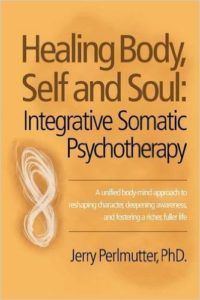Written by Jerry Perlmutter, PhD
Reviewed by Nancy Eichhorn, PhD
The task of writing for self-publication is worthy of attention as psychotherapists struggle with the urge to write and share their specific modalities in the center of a difficult reality—it’s hard to garner attention with major publishers such as W. W. Norton, Spring Publishing, North Atlantic Books, Karnac, and Jessica Kingsley Publishers. The book itself must be accurate, data must be supported, and the writing must engage the reader while informing, instructing and instituting a sense of connection and curiosity. At one point while writing Healing Body, Self and Soul, Dr. Perlmutter noted that he almost bailed. But a friend at the retirement community where Dr. Perlmutter lives helped him face and resolve a double bind he had created so he could complete the manuscript.
Healing Body, Self and Soul is a statement of a therapeutic process Dr. Perlmutter developed by integrating Reichian character structures, psychoanalysis, touch, breath, awareness and more. ISP is an amalgam of numerous concepts and interventions (e.g., inner child work, expressive movement, psychotherapy, hypnotherapy) that focuses on bodily events and processes necessary to shape the client’s mind and soul in an oscillatory process moving from body experiences to verbal reflection in order to cognitively integrate “new awareness, new experience of the deeper self and to foster behavior that is congruent with the deeper self” (p. xxiii).
Dr. Perlmutter offers readers a view into his work beginning with definitions and explanations of ISP. He discusses ISP’s guiding assumptions, concepts and values beginning with the “the most fundamental assumption of ISP”—“people have all the resources they need to heal and grow” (p. 1). The therapeutic relationship is given its due within the context of creating a safe container for self-exploration and expression. Reich’s character structures are delineated in easy to digest sentences, direct and to the point descriptions of the etiology, the body’s armoring, and interventions (touch is used extensively as depicted in black and white photographs, along with exercise interventions involving different movements). Case studies round out each chapter allowing readers to hear the process from clients’ perspectives as well as Dr. Perlmutter’s insights.
The Awareness Cycle and paradoxical change are two of the core principles in ISP, which are explained in detail in Chapter 2 along with explorations into soul and spirit (pp. 17-23). Chapter 3 highlights how trauma shapes character, the psychoanalytic perspective of character formation, and using character to structure ISP treatment. Chapters 4 through 9 explore each character structure with chapter 10 bringing it all together complete with ending therapy and ending the experience of writing this book.
While Healing Body, Self and Soul may not break any record sales, it does offer readers a simple way to experience one man’s lifetime working within a holistic integrative process to support his clients’ healing.
Dr. Perlmutter has been in private practice for 41 years. He was a founder, executive director, and fellow of the Midwest Institute for Somatic Psychotherapy. His background experiences creating ISP and his lifetime commitment to helping others are the foundation for his self-published book.
 Healing Body, Self and Soul: Integrative Somatic Psychotherapy
Healing Body, Self and Soul: Integrative Somatic Psychotherapy
Reviewed by Gregory Johanson, PhD as noted on Amazon.com
In Healing Body, Self and Soul, Perlmutter offers a mature, career-long account of his primary work, Integrative Somatic Psychotherapy. He outlines his use of body psychotherapy in the character work tradition of Reich, Lowen, and Brown including grounding, stress positions, hard and soft touch, externalizing introjects, strong expression of intense emotions, and more. This is integrated with a client-centered approach of keying off the spontaneous through honoring, and respecting unpredictable experiences as they arise in the client. Work is done in the context of an ongoing awareness cycle that promotes self-awareness, self-acknowledgement, self-acceptance and self-appreciation, which in the second stage of ISP therapy, following deep character work, leads into transformational explorations of one’s soul and the spirit connected to the soul’s energy. Clearly written and outlined with rich illustrations of the clinical theory.
Retrieved from Amazon.com: http://www.amazon.com/Healing-Body-Self-Soul-Psychotherapy/dp/1504335929






